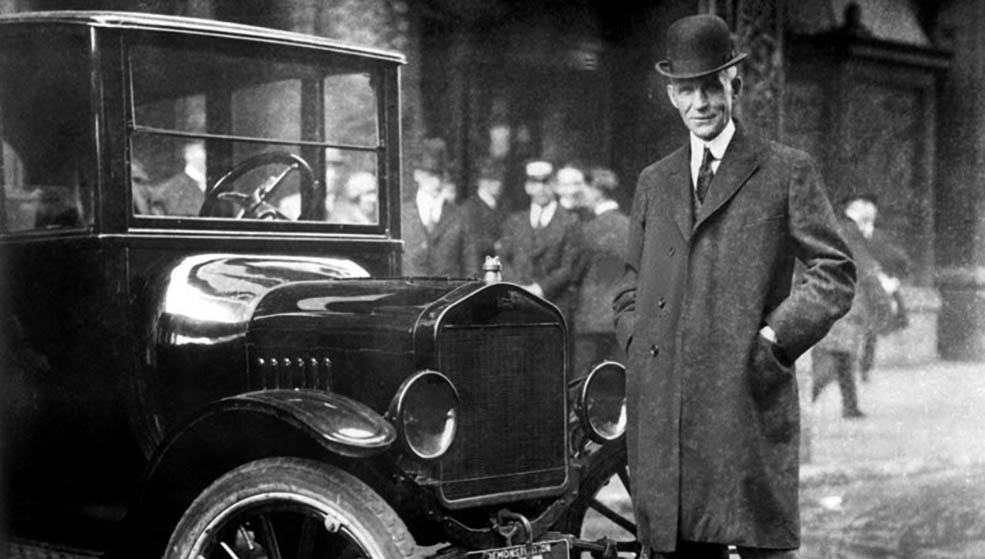During the mid-1920s, more than half of all the
automobiles in the world were nearly identical: the
legendary Ford Model T. This groundbreaking vehicle
didn't just dominate the roads - it revolutionized
personal transportation, making car ownership an
achievable dream for millions.

When Henry Ford first introduced the Model T on October
1, 1908, it came with a price tag of $850. While this
was already affordable compared to many other
automobiles of the time, Ford's relentless drive for
efficiency led to dramatic cost reductions. Thanks to
his pioneering advancements in mass production,
particularly the moving assembly line, the Model Tís
price eventually dropped to as little as $260. Ford
passed these savings directly to customers, ensuring
that more people than ever could afford their own car.
Affordable, Practical, Durable
The Model T wasnít just affordable - it was also
practical, durable, and remarkably innovative. Its
20-horsepower, four-cylinder engine could reach speeds
of about 45 miles per hour and delivered between 13 and
21 miles per gallon of gasoline. Weighing in at
approximately 1,200 pounds, it was light yet sturdy,
thanks to the use of vanadium steel, a strong yet
lightweight alloy specifically manufactured at Fordís
direction. This material gave the Model T excellent
durability without unnecessary weight, making it ideal
for the rough and often unpaved roads of the early 20th
century.
A true game-changer in automotive history, the Model T
was the first mass-produced vehicle built with
standardized interchangeable parts. This innovation not
only simplified production but also made repairs easier
and more affordable for owners. It also introduced
several industry-defining features, including the
left-side steering column and a single-engine block with
a removable cylinder head - design elements that would
become standard in future automobiles.
The Model Tís planetary transmission system made driving
more accessible to the average person, as it required
far less skill to operate than traditional manual
transmissions of the time. This simplified gear system
was, in many ways, a precursor to modern automatic
transmissions.
The
Universal Car
Henry Ford famously referred to the Model T as "the
universal car" - a vehicle designed to be reliable,
low-cost, and easy to maintain. Its three-point
suspension system helped it navigate the rough, unpaved
roads of rural America, and its versatility was
unmatched. The Model T was offered in nine different
body styles, all built on the same sturdy chassis. It
earned numerous affectionate nicknames, with "Lizzie"
being one of the most popular among the public.
Fordís innovative production techniques yielded
staggering results. In 1914, with just 13,000 employees,
Ford Motor Company produced around 300,000 Model T cars.
In contrast, 299 competing car manufacturers, with a
combined workforce of 66,350 employees, managed to
produce only about 280,000 vehicles in total. This
efficiency solidified Fordís dominance in the automotive
industry and changed manufacturing forever.
In addition to revolutionizing car production, Henry
Fordís influence extended to labor policies. He famously
introduced the $5 workday in 1914 - more than double the
average wage at the time. This allowed many of his own
workers to afford the very cars they were building,
further fueling the demand for automobiles.
By the time production of the Model T formally ended on
May 26, 1927, more than 15 million units had been built
and sold. A modest ceremony marked the end of an era,
but the Model Tís legacy was far from over.
100th Anniversary Celebration
To celebrate its 100th anniversary in 2008, Ford Motor
Company built six Model T replicas, known as the T-100
series, modeled after the original 1914 version.
Although these new versions didnít contain any original
Model T parts, every component was interchangeable with
the original design. Equipped with a nine-gallon gas
tank, the T-100s could reach a top speed of about 55
miles per hour and still achieved fuel efficiency
comparable to the 1914 Model T.
The Ford Model T was more than just a car - it was a
cultural icon that transformed transportation, industry,
and society. It paved the way for modern automobiles and
remains one of the most significant vehicles in history.
Even today, more than a century after its debut, the
Model T stands as a symbol of innovation, accessibility,
and the power of mass production to change the world.

